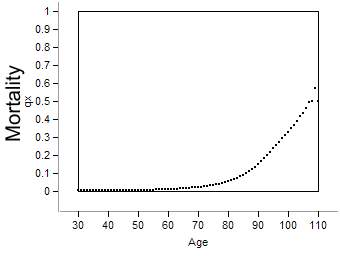We are born as individuals and die as imitations approaching death at an
accelerating pace, so we are told. From the age of 20 years and onward mortality
rate advances exponentially. Its nature was captured by the Gompertz equation,
known also as the Gompertz law of mortality: Mortality rate = m(b) = a*Exp[b*age].
b is the mortality coefficient. When death rates are plotted on a logarithmic
scale a straight line, known as Gompertz function is obtained. Log[a] +b*age.
Mortality rates for the 2002 US population. Source CDC/NCHS, National statistics
system, mortality
For more than a century gerontologists and demographers claimed that this
gloomy law governs our life, and since similar equations describe the fate
of machines, our organism follows the same rule. Aging is a gradual deterioration
of components, and accumulation of error. In
order to prolong the life of a machine it has to be equipped with redundant
components so that when one dies the other takes its place. The same applies
to us. Since aging is driven by an ongoing (random) deterioration of vital
genes, in order to attain old age one ought to be equipped with redundant
vital genes.
The
death of Gompertz law
Then came an “unpleasant” surprise. Their models failed to account for the
observed data. People lived longer and when they passed the age of 85 years
their mortality rate started declining (!). Beyond the age of 100y the mortality
rate approaches asymptotically a constant value. In other words, if you cross
the age of 80y and you are still healthy, your chances to cross the 100y mark
continually improve. Farewell to the Gompertz mortality law. The following
figure depicts the yearly mortality of US females living in 1999. The source
is the Human Life-Table Database http://www.lifetable.de/
 |
The curve looks Gompertzian and gloomy. On a semi-logarithmic paper it traces a line, like in the above figure, whose r-square is about 0.95. However, this simple linear regressions smoothes out important detail particularly since it is logarithmic. Let's take the mortality rate acceleration MA, which the difference between two subsequent points: MA = q[age] - q[age+1]. The next figure depicts the logarithm of the acceleration: Log[MA]. The red line is the best fit for the data between ages 30-60y (A) extrapolated to the age of 110y.
The A segment of the mortality rate accounts for a linear
loss of physiological functions, due to disuse .Phase B accounts for chronic
diseases, e.g. diabetes, and hypertension, which accelerate the mortality
rate. Segment C was discovered only recently. It is a manifestation of late
life. Up to the age of 95y, the longer you lived the greater were your chances
to die. Once reaching this advanced age, the longer you live the better your
chances to reach the 100y mark.
Aging-Yogi
What is the meaning of this plateau? Cartesian reductionists claim that some
people attain late life since they are equipped with redundant vital genes.
Your chances to reach the 120y are therefore slim, since nobody has enough
redundant vital genes to reach this age. However the future is bright. Evolution
minded demographers hope that evolution will create a new race (Methuselahs)
with ample redundant genes that will drive humanity to an ever advancing age.
Why not take destiny in our own hands and try to get older
even with a small set of vital redundant genes? Actually todays followers
of Methuselah seem to know how to reach the advanced age. Or better their
Wisdom of the Body (WOB) knows how to drive them to the advanced age.
What is its secret? Here such individuals are called Aging-Yogis. The Yogi
suffix is applied here to people with extraordinary capabilities, e.g., Cancer-Yogi
In the same way as a Hindu yogi controls his physiological functions
aging-yogis slow down their aging. They carry a secret which might be applied
to other people as well. This site investigates the secret of cancer-yogis.
Additional reading: How to slow down aging
Acceleration of age specific mortality
Steven A Frank studied age specific mortality accelerations in different diseases.
The following picture is part of Fig. 1 of his paper (1)
Fig. 1 Age-specific female mortality patterns. Data averaged
for the years 1999 and 2000 for non-Hispanic white females in the US from
statistics distributed by the National Center for Health Statistics (1)
Initially age specific mortality acceleration rises to a peak whereupon it
starts declining. Cancer mortality decelerates from the age of 50y and onward.
The older the patient with cancer the better her chances. The aging organism
(WOB) handles cancer better and better. The older she gets the better her
chances to become a cancer-yogi. The same applies to heart disease. Although
it starts decelerating somewhat later than cancer, the older he gets the better
his chances to become a heart-disease yogi.
More in: Age adjusted cancer mortality
Aging
is an ongoing process by which WOB attempts to creatively withstand external
threat. What appears to us as age deterioration is a successful attempt to
sustain life. The appearance of a healthy elderly is a token of his capability
to handle external threat. Contrary what the so called Gompertz law predicts
our fate lies in our hands.
References
1. Steven A Frank
A multistage theory of age-specific acceleration in human mortality ,BMC Biol.
2004; 2: 16.
http://www.pubmedcentral.nih.gov/articlerender.fcgi?artid=471577